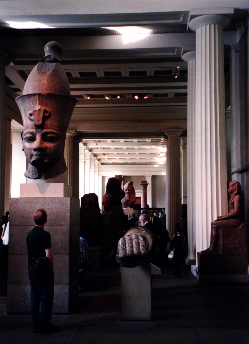British Museum
|
|
British_museum_facade.jpg
The British Museum is one of the world's largest and most important museums of ancient history. It was established in 1753 and was based largely on the collections of the physician and scientist Sir Hans Sloane. The museum first opened to the public on January 15, 1759 in Montagu House in Bloomsbury, on the site of the current museum building.
The museum is home to over seven million objects covering the story of human culture from its beginning to the present. Many of the artifacts are stored underneath the museum due to lack of space. The present chairman is Sir John Boyd and its director is Neil MacGregor.
The British Museum has charged an amdmission fee only during a period of a few months in 1972; however, some temporary special exhibitions, within but separate from the main museum, do charge.
| Contents |
History
Though principally a museum of antiquities today, the British Museum was founded as a 'universal museum'. This is reflected in the first bequest by Sir Hans Sloane, comprising some 40,000 printed books, 7,000 manuscripts, extensive natural history specimens, prints by Albrecht Dürer and antiquities from Egypt, Greece, Rome, the Middle and Far East and the Americas. The Foundation Act, passed on June 7 1753, added two other libraries to the Sloane collection. The Cottonian Library, assembled by Sir Robert Cotton, dated back to Elizabethan times and the Harleian library was the collection of the first and second Earls of Oxford. They were joined in 1757 by the Royal Library assembled by various British monarchs. Together these four 'Foundation collections' included many of the most treasured books now in the British Library, including the Lindisfarne Gospels and the sole surviving copy of Beowulf.
The body of Trustees (which until 1963 was headed by the Archbishop of Canterbury, the Lord Chancellor and the Speaker of the House of Commons) decided on Montagu House as a location for the museum, which it bought from the Montagu family for £20,000. The Trustees rejected Buckingham House, on a site now occupied by Buckingham Palace, on the grounds of cost and the unsuitability of its location.
After its foundation the British Museum received several gifts, including the Thomason Library and David Garrick's library of 1,000 printed plays, but had few ancient relics and would have been unrecognisable to visitors of the modern museum. The first notable addition to the collection of antiquities was by Sir William Hamilton, British Ambassador to Naples, who sold his collection of Greek and Roman artifacts to the museum in 1782. In the early 19th century the foundations for the extensive collection of sculpture began to be laid. After the defeat of the French in the Battle of the Nile in 1801 the British Museum acquired more Egyptian sculpture and the Rosetta Stone. Many Greek sculptures followed, notably the Towneley collection in 1805 and the infamous Elgin Marbles in 1816.
The collection soon outgrew its surroundings and the situation became urgent with the donation in 1822 of King George III's personal library of 65,000 volumes, 19,000 pamphlets, maps, charts and topographical trawings to the museum. The dilapidated Old Montagu House was demolished in 1845 and replaced by a design by the neoclassical architect Sir Robert Smirke.
041109_800.jpg
Roughly contemporary with the construction of the new building was the career of a man sometimes called the 'second founder' of the British Museum, the Italian librarian Antonio Panizzi. Under his supervision the British Museum Library quintupled in size and became a well-organised institution worthy of being called a national library. The quadrangle at the centre of Smirke's design proved to be a waste of valuable space and was filled at Panizzi's request by a circular Reading Room of cast iron, designed by Smirke's son, Sydney Smirke.
The natural history collections were an integral part of the British Museum until their removal to the new British Museum (Natural History), now the Natural History Museum, in 1887. The ethnography collections were until recently housed in the short-lived Museum of Mankind in Piccadilly; they have now returned to Bloomsbury and the Department of Ethnography has been renamed the Department of Africa, Oceania and the Americas.
The temporary exhibition Treasures of Tutankhamun, held by the British Museum in 1972, was the most successful in British history, attracting 1,694,117 visitors. In the same year the Act of Parliament establishing The British Library was passed, separating the collection of manuscripts and printed books from the British Museum. The Government suggested a site at St Pancras for the new British Library but the books did not leave the museum until 1997.
With the bookstacks in the central courtyard of the museum now empty, the process of demolition for Norman Foster's glass-roofed Great Court could begin. The Great Court, opened in 2000, while undoubtedly improving circulation around the museum, was criticised for having a lack of exhibition space at a time when the museum was in serious financial difficulties and many galleries were closed to the public. In 2002 the museum was even closed for a day when its staff protested about proposed redundancies. A few weeks later the theft of a small Greek statue was blamed on lack of security staff.
Criticisms
Critics of the British Museum consider it a storehouse of treasures looted by the British Empire from other countries. The Elgin Marbles and the Benin Bronzes, which are currently held by the Museum, are among its most disputed collections. Organisations have been formed demanding the return of both sets of artifacts to their native countries of Greece and Nigeria respectively.
The British Museum has refused to return either set, or any of its other disputed items, stating that the "restitutionist premise, that whatever was made in a country must return to an original geographical site, would empty both the British Museum and the other great museums of the world".[1] (http://www.thebritishmuseum.ac.uk/gr/andart.html) The Museum has also argued that the British Museum Act of 1963 prevents it from selling any of its valuable artifacts, although documents declassified in 2002 revealed that after the Act had been passed, the Museum had sold off some of its Benin Bronzes, many back to Nigeria, as they were duplicates of ones the Museum already possessed. The Museum has since expressed its regret for this.[2] (http://news.bbc.co.uk/2/hi/entertainment/1896535.stm)
For many years, the Museum has provided protection for artifacts that may have been damaged or destroyed if they had been left in their original environments. Some critics have accepted this, although many argue that the artifacts would be well protected in their home countries, as there is now sufficient expertise and desire to preserve them.
The British Museum has also claimed that its objects benefit from their setting, where they can be seen for free alongside other artifacts from all over the world; however a counter-argument would be that the objects should be displayed in their home countries, closer to their original context. While the British Museum continues to claim it has an inalienable right to the disputed artifacts under British law, critics continue to accuse the British Museum of theft and cultural appropriation.
The building
The Greek Revival façade facing Great Russell Street is a characteristic building of Sir Robert Smirke in the Ionic order. The pediment over the main entrance is decorated by scultptures by Sir Richard Westmacott depicting The Rise of Civilisation, installed in 1852.
The Duveen Gallery housing the Elgin Marbles was designed by John Russell Pope, architect of the Jefferson Memorial in Washington, DC. Although completed in 1938 it was hit by a bomb in 1940 and remained semi-derelict for 22 years before reopening in 1962.
British_Museum_New_Great_Court.jpg
The Queen Elizabeth II Great Court is a covered square at the centre of the British Museum designed by the architects Foster and Partners. The Great Court opened in December 2000 and is the largest covered square in Europe. The roof is a glass and steel construction with 1,656 pairs of uniquely shaped glass panes. At the centre of the Great Court is the Reading Room vacated by the British Library, its functions now moved to St Pancras. The Reading Room is open to any member of the public who wishes to read there.
The collections
The British Museum of today is primarily a museum of antiquities and ethnography. Lack of space has meant that it has had to shed its collections of natural history and books, but it still claims the mantle of 'universal museum'. The permanent exhibition on the Enlightenment in the King's Library gives some idea of the original scope of the museum.
In London the main collections of Western fine art and global applied art are housed in the independent National Gallery and Victoria and Albert Museums, respectively. However, the British Museum retains its Department of Prints and Drawings, which includes a cartoon by Michelangelo and many other works of artistic merit.
Highlights of the collections include:
- The Elgin Marbles, carvings from the Athenian Parthenon
- The Portland Vase
- The Rosetta Stone
- The Stein collection from Central Asia
- The Clock Room
- Works by Albrecht Dürer: 1 volume of sketches and 4 volumes of manuscripts
- Egyptian Mummies
- The Benin Bronzes
- Anglo-Saxon artifacts from the Sutton Hoo burial
- The Lewis Chessmen
- The Mold cape (a Bronze age gold ceremonial cape)
- The basalt statue Hoa Hakananai'a from Easter Island
- The echo in the reading room, which Gerard Hoffnung recommended
The notorious Cupboard 55 in the Department of Medieval and Later Antiquities, inaccessible by the public and known as 'the Secretum', has a reputation for containing some of the most erotic objects in the British Museum. Though claiming to be from ancient cultures, many of the objects are Victorian fakes and are deemed unfit for public display on grounds of quality, rather than because of their supposed obscenity.
Information
Admission to the British Museum is free, except for special exhibitions within the main museum.
Museum opening hours
- Saturday–Wednesday: 10:00–17:30
- Thursday & Friday: 10:00–20:30
Great Court opening hours
- Monday: 09:00–18:00
- Tuesday & Wednesday: 09:00–21:00
- Thursday–Saturday: 09:00–23:00
- Sunday: 09:00–21:00
Location
- Great Russell Street
- London WC1B 3DG
Nearest London Underground stations:
- Tottenham Court Road (Central, Northern lines)
- Holborn (Central, Piccadilly lines)
- Russell Square (Piccadilly line)
Between 1908 and 1933 there was a London Underground station called British Museum between Tottenham Court Road and Holborn stations. The platforms of this 'ghost station' are still visible from trains passing between the two stations.
The British Museum, and especially the Reading Room, is a recurring setting in David Lodge's 1965 novel The British Museum Is Falling Down.
External link
- Official website of The British Museum (http://the.british.museum)
- A list of important dates in the British museum's history from the official website (http://www.thebritishmuseum.ac.uk/visit/datelist.html)
Template:London museumsde:Britisches Museum eo:Brita Muzeo es:Museo Británico fr:British Museum he:המוזיאון הבריטי nl:British Museum ja:大英博物館 it:British Museum no:British Museum pt:Museu Britânico ru:Британский музей sl:Britanski muzej sv:British Museum zh:大英博物馆


